View/Open - Indiana State University
advertisement
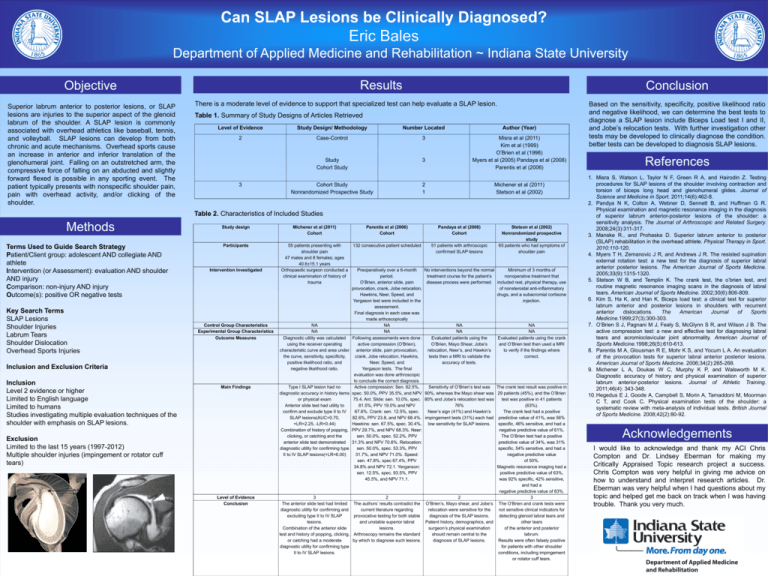
Can SLAP Lesions be Clinically Diagnosed? Eric Bales Department of Applied Medicine and Rehabilitation ~ Indiana State University Results Objective Superior labrum anterior to posterior lesions, or SLAP lesions are injuries to the superior aspect of the glenoid labrum of the shoulder. A SLAP lesion is commonly associated with overhead athletics like baseball, tennis, and volleyball. SLAP lesions can develop from both chronic and acute mechanisms. Overhead sports cause an increase in anterior and inferior translation of the glenohumeral joint. Falling on an outstretched arm, the compressive force of falling on an abducted and slightly forward flexed is possible in any sporting event. The patient typically presents with nonspecific shoulder pain, pain with overhead activity, and/or clicking of the shoulder. Conclusion There is a moderate level of evidence to support that specialized test can help evaluate a SLAP lesion. Table 1. Summary of Study Designs of Articles Retrieved Level of Evidence Study Design/ Methodology Number Located Author (Year) 2 Case-Control 3 Study Cohort Study 3 Misra et al (2011) Kim et al (1999) O’Brien et al (1998) Myers et al (2005) Pandaya et al (2008) Parentis et al (2006) 3 Cohort Study Nonrandomized Prospective Study 2 1 Michener et al (2011) Stetson et al (2002) Table 2. Characteristics of Included Studies Methods Terms Used to Guide Search Strategy Patient/Client group: adolescent AND collegiate AND athlete Intervention (or Assessment): evaluation AND shoulder AND injury Comparison: non-injury AND injury Outcome(s): positive OR negative tests Key Search Terms SLAP Lesions Shoulder Injuries Labrum Tears Shoulder Dislocation Overhead Sports Injuries Study design Michener et al (2011) Cohort Parentis et al (2006) Cohort Pandaya et al (2008) Cohort Participants 55 patients presenting with shoulder pain 47 males and 8 females; ages 40.6±15.1 years Orthopaedic surgeon conducted a clinical examination of history of trauma 132 consecutive patient scheduled 51 patients with arthroscopic confirmed SLAP lesions Intervention Investigated Control Group Characteristics Experimental Group Characteristics Outcome Measures NA NA Diagnostic utility was calculated using the receiver operating characteristic curve and area under the curve, sensitivity, specificity, positive likelihood ratio, and negative likelihood ratio. Main Findings Type I SLAP lesion had no diagnostic accuracy in history items or physical exam Anterior slide test had utility to confirm and exclude type II to IV SLAP lesions(AUC=0.70, +LR=2.25, -LR=0.44) Combination of history of popping, clicking, or catching and the anterior slide test demonstrated diagnostic utility for confirming type II to IV SLAP lesions(+LR=6.00) Inclusion and Exclusion Criteria Inclusion Level 2 evidence or higher Limited to English language Limited to humans Studies investigating multiple evaluation techniques of the shoulder with emphasis on SLAP lesions. Exclusion Limited to the last 15 years (1997-2012) Multiple shoulder injuries (impingement or rotator cuff tears) Level of Evidence Conclusion Preoperatively over a 6-month period. O’Brien, anterior slide, pain provocation, crank, Jobe relocation, Hawkins, Neer, Speed, and Yergason test were included in the assessment. Final diagnosis in each case was made arthoscopically NA NA Following assessments were done: active compression (O’Brien), anterior slide, pain provocation, crank, Jobe relocation, Hawkins, Neer, Speed, and Yergason tests. The final evaluation was done arthroscopic to conclude the correct diagnosis. Active compression: Sen. 62.5%, spec. 50.0%, PPV 35.5%, and NPV 75.4. Ant. Slide: sen. 10.0%, spec. 81.5%, PPV 19.0% and NPV 67.6%. Crank: sen. 12.5%, spec. 82.6%, PPV 23.8, and NPV 68.4%. Hawkins: sen. 67.5%, spec. 30.4%, PPV 29.7%, and NPV 68.3%. Neer: sen. 50.0%, spec. 52.2%, PPV 31.3% and NPV 70.6%. Relocation: sen. 50.0%, spec. 53.3%, PPV 31.7%, and NPV 71.0%. Speed: sen. 47.8%, spec 67.4%, PPV 34.8% and NPV 72.1. Yerganson: sen. 12.5%, spec. 93.5%, PPV 45.5%, and NPV 71.1. Stetson et al (2002) Nonrandomized prospective study 65 patients who had symptoms of shoulder pain No interventions beyond the normal Minimum of 3 months of treatment course for the patient’s nonoperative treatment that disease process were performed. included rest, physical therapy, use of nonsteroidal anti-inflammatory drugs, and a subacromial cortisone injection. NA NA Evaluated patients using the O’Brien, Mayo Shear, Jobe’s relocation, Neer’s, and Hawkin’s tests then a MRI to validate the accuracy of tests. Sensitivity of O’Brien’s test was 90%, whereas the Mayo shear was 80% and Jobe’s relocation test was 76% Neer’s sign (41%) and Hawkin’s impingement tests (31%) each had low sensitivity for SLAP lesions. NA NA Evaluated patients using the crank and O’Brien test then used a MRI to verify if the findings where correct. The crank test result was positive in 29 patients (45%), and the O’Brien test was positive in 41 patients (63%). The crank test had a positive predictive value of 41%, was 56% specific, 46% sensitive, and had a negative predictive value of 61%. The O’Brien test had a positive predictive value of 34%, was 31% specific, 54% sensitive, and had a negative predictive value of 50%. Magnetic resonance imaging had a positive predictive value of 63%, was 92% specific, 42% sensitive, and had a negative predictive value of 83%. 3 2 2 3 The anterior slide test had limited The authors’ results contradict the O’Brien’s, Mayo shear, and Jobe’s The O’Brien and crank tests were diagnostic utility for confirming and current literature regarding relocation were sensitive for the not sensitive clinical indicators for excluding type II to IV SLAP provocative testing for both stable diagnosis of the SLAP lesions. detecting glenoid labral tears and lesions. and unstable superior labral Patient history, demographics, and other tears Combination of the anterior slide lesions. surgeon’s physical examination of the anterior and posterior test and history of popping, clicking, Arthroscopy remains the standard should remain central to the labrum. or catching had a moderate by which to diagnose such lesions. diagnosis of SLAP lesions. Results were often falsely positive diagnostic utility for confirming type for patients with other shoulder II to IV SLAP lesions. conditions, including impingement or rotator cuff tears. Based on the sensitivity, specificity, positive likelihood ratio and negative likelihood, we can determine the best tests to diagnose a SLAP lesion include Biceps Load test I and II, and Jobe’s relocation tests. With further investigation other tests may be developed to clinically diagnose the condition. better tests can be developed to diagnosis SLAP lesions. References 1. Misra S, Watson L, Taylor N F, Green R A, and Hairodin Z. Testing procedures for SLAP lesions of the shoulder involving contraction and torsion of biceps long head and glenohumeral glides. Journal of Science and Medicine in Sport. 2011;14(6):462-8. 2. Pandya N K, Colton A, Webner D, Sennett B, and Huffman G R. Physical examination and magnetic resonance imaging in the diagnosis of superior labrum anterior-posterior lesions of the shoulder: a sensitivity analysis. The Journal of Arthroscopic and Related Surgery. 2008;24(3):311-317. 3. Manske R., and Prohaska D. Superior labrum anterior to posterior (SLAP) rehabilitation in the overhead athlete. Physical Therapy in Sport. 2010:110-120. 4. Myers T H, Zemanovic J R, and Andrews J R. The resisted supination external rotation test: a new test for the diagnosis of superior labral anterior posterior lesions. The American Journal of Sports Medicine. 2005;33(9):1315-1320. 5. Stetson W B, and Templin K. The crank test, the o’brien test, and routine magnetic resonance imaging scans in the diagnosis of labral tears. American Journal of Sports Medicine. 2002;30(6):806-809. 6. Kim S, Ha K, and Han K. Biceps load test: a clinical test for superior labrum anterior and posterior lesions in shoulders with recurrent anterior dislocations. The American Journal of Sports Medicine.1999;27(3):300-303. 7. O’Brien S J, Pagnani M J, Fealy S, McGlynn S R, and Wilson J B. The active compression test: a new and effective test for diagnosing labral tears and acromioclavicular joint abnormality. American Journal of Sports Medicine.1998;26(5):610-613. 8. Parentis M A, Glousman R E, Mohr K S, and Yocum L A. An evaluation of the provocation tests for superior labral anterior posterior lesions. American Journal of Sports Medicine. 2006;34(2):265-268. 9. Michener L A, Doukas W C, Murphy K P, and Walsworth M K. Diagnostic accuracy of history and physical examination of superior labrum anterior-posterior lesions. Journal of Athletic Training. 2011;46(4): 343-348. 10. Hegedus E J, Goode A, Campbell S, Morin A, Tamaddoni M, Moorman C T, and Cook C. Physical examination tests of the shoulder: a systematic review with meta-analysis of individual tests. British Journal of Sports Medicine. 2008;42(2):80-92. Acknowledgements I would like to acknowledge and thank my ACI Chris Compton and Dr. Lindsey Eberman for making my Critically Appraised Topic research project a success. Chris Compton was very helpful in giving me advice on how to understand and interpret research articles. Dr. Eberman was very helpful when I had questions about my topic and helped get me back on track when I was having trouble. Thank you very much.
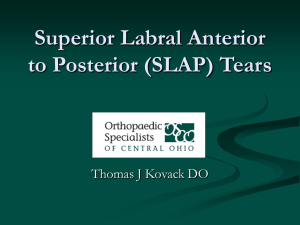
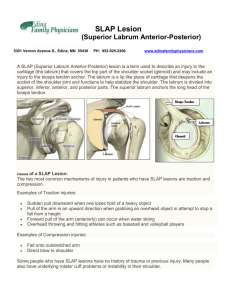
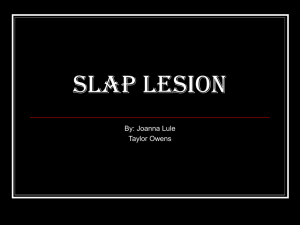
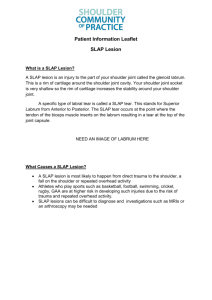
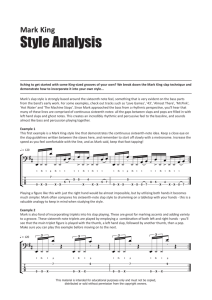

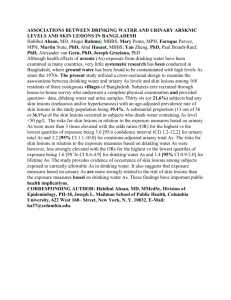
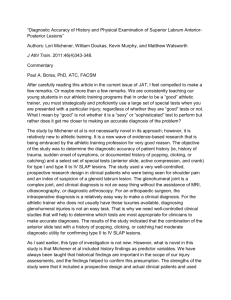
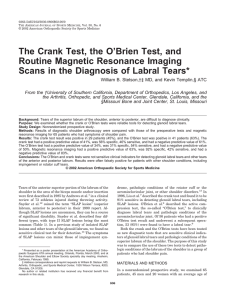
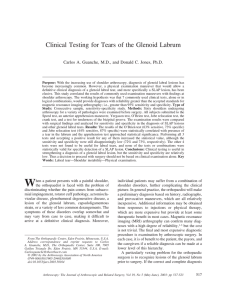
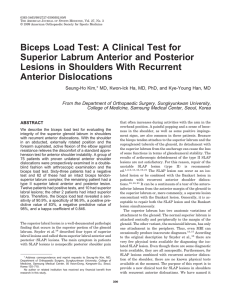
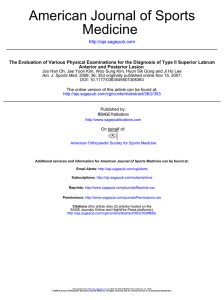
![S [ ] SLAP Lesions: An Update on](http://s2.studylib.net/store/data/010804765_1-53b49bd6580b311794b2156690c8e10c-300x300.png)